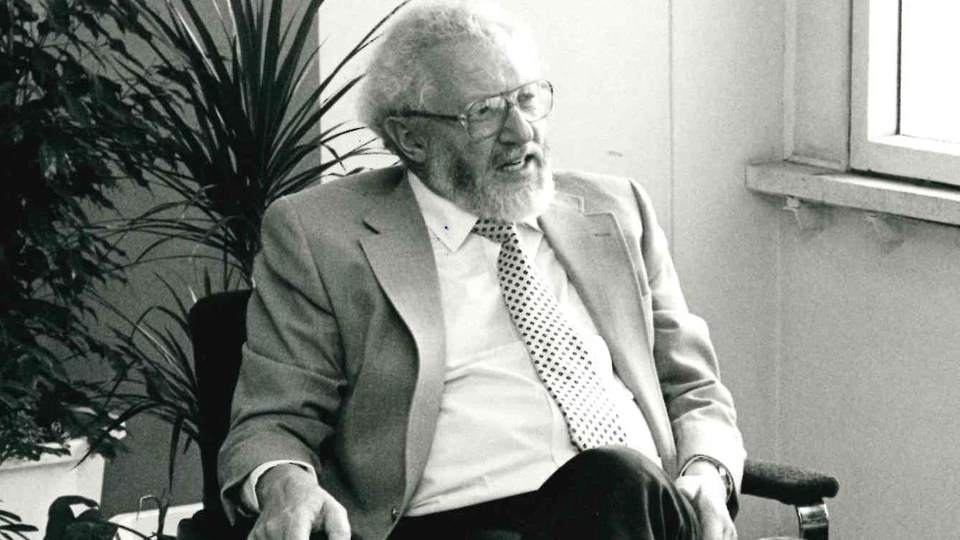PDI mourns the loss of Prof. Herbert Krömer
/ Announcements
Professor Herbert Krömer, an independent mind and rebellious spirit, was one of the pioneers of semiconductor physics. His groundbreaking contributions revolutionized the landscape of modern semiconductor technology and enabled modern wireless communication technology. He passed away on March 8th, 2024, in Santa Barbara, USA, at the age of 95.
Born on August 25, 1928, in Weimar, Herb Krömer decided to study physics and was admitted to the University of Jena in 1947. Due to the severe political oppression he witnessed in East Germany, he took one of the empty Berlin airlift flights back to the West German Sector to continue his studies in Göttingen. After receiving his PhD in 1952 at the age of 24, he worked at the Central Telecommunication Labs (Fernmeldetechnisches Zentralamt FTZ) of the German postal service, where he began to envision semiconductor heterostructures as potential solutions to fundamental technological problems present in bulk semiconductor materials.
Krömer soon ventured further West to the United States. His extraordinary career brought him to the most prestigious institutions, where he shaped the world of semiconductors through his seminal theoretical studies and profound insights that opened entirely new research avenues into new principles of semiconductor materials. He laid the foundation for transformative advancements in semiconductor technology. His theoretical calculations in 1957, conducted while at RCA Laboratories in Princeton, New Jersey, heralded the superiority of heterostructure transistors over conventional ones, unlocking new possibilities for high-frequency applications. His groundbreaking work eventually spurred the development of the first practical heterostructure electronic device in 1966—a true revolution.
Krömer considered himself an Applied Theorist, laying the foundation for transformative advancements through theoretical analysis. He recognized the potential of molecular beam epitaxy early on as a thin film growth method to synthesize semiconductor heterostructures with high precision, testing theoretical predictions and ultimately realizing electronic devices based on these novel concepts. An excellent communicator and community builder, he saw opportunities beyond theoretical analysis, encompassing materials science and electrical engineering aspects to unleash the transformative power of interdisciplinary approaches in advancing semiconductor heterostructure; many will remember him urging “let them try it!”. Krömer was an early pioneer and enabler of molecular beam epitaxy, instrumental in building the first molecular beam epitaxy lab at the University of California, Santa Barbara (UCSB), which he joined in 1976. In 2000, he was awarded the Nobel Prize in Physics, alongside Zhores I. Alferov, "for developing semiconductor heterostructures used in high-speed- and opto-electronics," and with Jack S. Kilby for his part in the invention of the integrated circuit.
The Paul Drude Institute for Solid State Electronics mourns his loss, remembering Herb Krömer as one of the most influential voices during critical times of the institute’s development. With the reunification of Germany in 1989, a dramatic reorganization of the scientific landscape was imminent. Krömer served on the institute’s founding advisory board from 1993 to 1995, helping establish the institute during these years and positioning it as one of the leading institutions for MBE-growth of tailored semiconductor materials.
The founding director of PDI, Prof. Dr. Klaus Ploog, recalls Herb Krömer’s pivotal role: “Herb’s honest and clear opinion on our performance and his suggestions for future research helped the members of PDI find their own role in the international research community. It sometimes motivated researchers to change their previous research subjects to novel ones and encouraged a few researchers to spend future sabbaticals abroad.”
The current PDI director, Prof. Dr. Roman Engel-Herbert, remembers his interaction with Krömer during his time in the MBE labs at UCSB: “We were focused on overcoming a fundamental synthesis challenge for the growth of oxide heterostructures by MBE. Herb's genuine interest and encouraging words refueled our drive and passion to overcome the remaining obstacles. He inspired us to try even harder.”
Krömer's upbringing and early career in Germany, followed by his tremendous successes in the USA, provided him with a deep understanding of two fundamentally different societies. This gave him the ability not only to see but also to alleviate the challenges of integrating a culturally diverse team in the dynamically developing reunifying Berlin. Especially in the early years of the institute, he helped bridge the large cultural differences at PDI. We are saddened and will dearly miss the exceptional physicist, the rebellious mind and independent thinker, who was not afraid to speak up—"let them try it!"—the pioneer of molecular beam epitaxy, the influential supporter, and the wise and integrative force that he was—our long-time friend, Herb Krömer.
